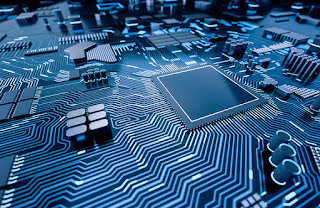Elements of Quantum Computing and its Features
Computers are facing many technical revolutions for years. They are getting smaller and faster with each day as electronic components are getting smaller, but this process is reaching its physical limits.
Electricity
being the flow of electrons is used as a switch as electrons are able to
transfer to the other side of a blocked path by a process called quantum
tunneling.
Quantum
mechanics is a branch of physics that studies the physical world at the most
basic level. At this level, the particles behave differently than in the
classical world. In that, they assume more than one state at the same time and
interact with other distant particles. Superposition and entanglement phenomena
occur in this.
Superposition:
In classic
computing, some bits have two possible states, either zero or one. In quantum
computing, a qubit (short for “quantum bit”) is a unit of quantum information,
the quantum analog of a classical bit.
Qubits carry
significant properties that help solve complex problems much faster than
classic bits. One of these properties is known as superposition. This states
that a qubit can contain a combination of “0” and “1” at the same time instead
of a binary value (“0” or “1”) like a classic bit.
In the
quantum world, the qubit does not have to be in one of these states. It can be
in any proportion of the states. Once we measure its value, we have to decide
whether it is zero or one. This is known as superposition. The quantum system
can be in several states at the same time. In classic computing, for example,
it is 4 bytes. The 4-byte combination can represent 2 ^ 4 = 16 total values
and one value at a specific point in time. When combining four qubits, all 16
combinations are possible at the same time.
Entanglement
Entanglement
is an extremely compact correlation that exists between the quantum particles –
actually so strong that two or more quantum particles can perfectly combine
with each other even if they are separated by great distances.
The
particles behave in perfect correlation even at great distances. Two qubits are
entangled by a laser, the moment they are entangled, they remain in an
indefinite state, the qubits can be separated from one another as far as
desired, and they remain connected. If one of the qubits is manipulated, the
manipulation occurs immediately to its entangled twin all at the same time.
Quantum
theory
The
development of quantum theory began in 1900 with a lecture by Max Planck to the
German Physical Society, in which Planck presented the idea that energy and
matter exist in individual units. Several other developments by different
scientists also led to the modern understanding of quantum theory.
Its
Elements:
Like matter,
energy consists of special units; In contrast to a continuous wave, elementary
particles made of energy and matter can behave like particles or waves,
depending on the conditions.
The movement
of elementary particles is by nature random and hence very unpredictable.
The
simultaneous measurement of two complementary values: such as position and
momentum of a particle, is defective. The more precisely a value is measured,
the more erroneous it becomes for the measurement of the other value.
Differentiation
between Classical and Quantum Computing:
The quantum
computer works with a logic gate in two modes: XOR and a mode called QO1 (the
ability to change 0 in a superposition of 0 and 1). Various elementary
particles such as electrons or photons can be generated in a quantum computer.
Each
particle receives a charge or polarization that acts as a representation of 0
and/or 1. Each particle is called a quantum bit or qubit. The two most important
aspects of quantum physics are the principles of superposition and
entanglement.
Classical
computing is based on the ideologies of Boolean algebra; usually, it works on a
logic gate principle with 3 or 7 modes. The data must be processed in a clear binary
state at all times; 0 (off / false) or 1 (on / true). These values are only
in binary digits or bits.
The millions
of transistors and capacitors can only be in one state at a time.
There is
still a limit to how fast these devices can change state. As we move towards
smaller and faster circuits, we begin to reach the physical limits of materials
and the threshold for applying the classical laws of physics.
Information
about Quantum Programming:
Quantum
Computing offers the possibility to write programs in a whole new way. For
example, a quantum computer could contain a programming sequence that would
look something like “taking all the superpositions of all previous
calculations.”
This would
allow extremely quick ways to solve certain math problems, such as factoring in
large numbers.
Hi guys! My
name is Jerry turner and I’m from UK I have been working around printers for 10
years. Canon printers are the easiest to install and set up. They require
minimal effort with proper installation knowledge. You can download
Canon.com/ijsetup and manuals easily from the Internet

Comments
Post a Comment